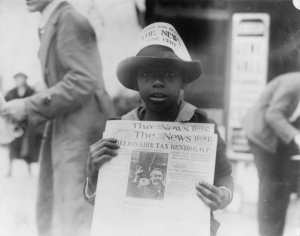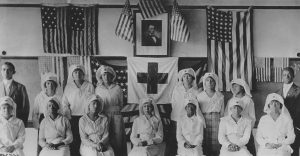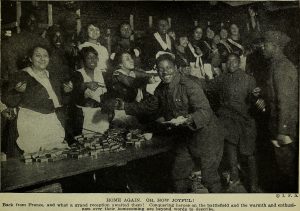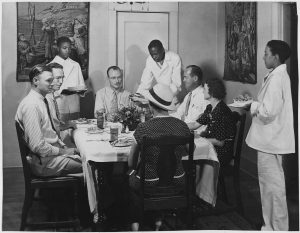36 African Americans in the Interwar Years By Hannah Jones
1. Source analysis: African Americans in the interwar years

African American boy selling The Washington Daily News, National Photo Company Collection, Public Domain
| Curriculum Context | VCE Unit 2 Modern History: Changing World Order (VCAA,2020) |
| Historical Context | Interwar Years> African Americans in the Interwar Period |
| Historical Thinking Concepts | Ask and Use Historical Questions
Source Analysis |
| Learning Intention | Develop the skills involved in source analysis and broaden their knowledge of African American perspectives during the interwar period. |
Activity
Analyse the following primary and secondary sources annotating and paraphrasing where appropriate. For each of the sources below answer the following questions:
- Describe what you see?
- Who made this source and when was it made?
- Who is depicted in this source and how are they represented?
- What is the purpose of this source?
- What is the socio-political climate surrounding this source?
- What information can be gathered from the sources in relation to the socio-political climate?
Primary Sources:
Source 1: American Red Cross – Classes in Red Cross Work (workrooms and classes) – Colored girls doing Red Cross Work C.P.I War Department, Wikimedia Commons, Public Domain

Source 2: Kelly Miller’s history of the world war for human right Kelly Miller, Wikimedia Commons, Public Domain

Transcript:
‘HOME AGAIN. OH, HOW JOYFUL!
Back from France, and what a grand reception awaited them! Conquering heroes on the battlefield and the warmth and enthusiasm over their homecoming are beyond words to describe.’
Source 3: ‘Coloured Boys’ Attending Workers Training ’ Wikimedia Commons, Unknown Author, Public Domain

Secondary Source:
Source 1: As Pawłowska (2014, pp. 5-6) discusses, the New Negro Art during the Interwar period reflects an ambivalence within African-American culture.
THE NEW NEGRO MOVEMENT
“During the Interwar period African-Americans seized the opportunity to promote political, economic and social agendas that would benefit the black community nationally. Organizations like the National Association for the Advancement of Colored People (NAACP) and the National Urban League were instrumental in promoting the New Negro movement, also called the Negro or Harlem Renaissance, in their respective journals, “Crisis” (1910), and “Opportunity” (1922). The Negro Renaissance denoted a cultural revitalization in the cities. Its capital was Harlem (uptown Manhattan in New York), which had the largest African-American urban population. The Harlem Renaissance consequently represented most visibly what was also happening in other major American cities. The cultural historian Nathan Huggins noted that: The Negro Renaissance was a struggle to show an African-American cultural “coming of age” that paralleled the same phenomena [sic] in American culture as it moved from under European cultural hegemony, and sought to reinvigorate itself. Literature, theatre, visual arts and, later, music were seen as a means to define and establish “membership in the African or black race,” and simultaneously to enhance the reputation and self-esteem of African-Americans in America.
As was noted by the novelist James Weldon Johnson (1871-1938) in The Book of Negro Poetry (1927), “No people that has ever produced great literature and art has ever been looked on by the world as distinctly inferior.” Achievement was not to be defined by that cultural production which only imitated European or white America, but by an art which expressed a distinctive African-American cultural identity, most strongly grounded in folk culture. This expressive and mature African-American was the New Negro. The ideology of the concept replaced that of the “race” of the men (and women) of the previous century. It was incumbent upon the black middle class, whom W.E.B. Du Bois called the “Talented Tenth” (approximately ten per cent were educated in the middle class), to lead the way, and consequently to prove their worthiness as American citizens, and provide role models for the less fortunate African-Americans.”
(Pawłowska, 2014, pp. 5-6)
References
Pawłowska, A (2014), The Ambivalence of the African-American culture: the new negro art in the interwar period, Art Inquiry. Recherches sur les arts, vol. XVI, ISSN 1641-9278, Department of Art History, University of Łódź. https://cejsh.icm.edu.pl/cejsh/element/bwmeta1.element.desklight-809b3e46-4cbc-4bc6-8b6a-a93d68215ccd
VCAA. (2020). VCE Study Design: History 2022-2026. Victorian Curriculum And Assessment Authority. https://www.vcaa.vic.edu.au/curriculum/vce/vce-study-designs/history/Pages/index.aspx
Wiscount, L. A., Halovanic, E., & Mariner, V (2023) Analyzing Images, OER Commons. https://oercommons.org/courseware/lesson/69428/overview
2. Head, heart, and conscience: African-American experiences and perspectives in the interwar years

Girl With Umbrella 1937 by Dorethea Lange, Public Domain
| Curriculum Context | VCE Unit 2 Modern History: Changing World Order (VCAA,2020) |
| Historical Context | Modern History > African Americans in the Interwar Period |
| Historical Thinking Concepts | Explore Historical Perspectives |
| Learning Intention | Select and investigate an African American perspective, communicating this in the form of a head, heart, and conscience activity |
Activity
Your task, in groups of 3, is to undertake an extended investigation into the experiences and perspectives of African Americans and how they evolved and changed during the interwar period (1918-1939). Complete the following ‘Head, Heart, and Conscience activity’.
Select and focus on one of the following:
- African American Soldiers
- African American Women
- African American Migrants
- LGBTQIA+ African Americans
Please approach the teacher if you have any alternative African American people groups to investigate.
Head, Heart, and Conscience
HEAD:
How did the Interwar period impact continuity and change to the social life and experience of African Americans?
What were the perspectives and experiences of those affected by such social and cultural change?
Analyse the conditions which influenced these changes, such as World War I, socio-political changes, and economic conditions.
HEART:
What emotions does this raise for you?
Are there any moments, images, or stories that stand out?
CONSCIENCE:
What questions about justice, fairness, and equity does this raise for you?
What choices did key figures make and what values may have guided those choices?
How were people impacted by this event? Are there any peoples who should be held accountable? If so, who?
The following resources are available to assist you, however, you are encouraged to research a wide variety of materials to bring depth to your investigation.
African American Migrants:
Definition, Causes & Impact – HISTORY
African American Soldiers:
Smithsonian Institution (si.edu)
African American Women:
LGBTQIA+ African Americans:
Queer and African American Women in Interwar Period
Timeline: African American LGBTQ+ U.S.
Queering African American History
Extra Resources:
World War One:
How WWI Changed America: African Americans in WWI – YouTube
World War I: The African American Experience – YouTube
Economy
ECONOMY in the INTERWAR Period
The Great Depression
Race Relations in the 1930s and 1940s
African Americans – Great Depression, New Deal, Struggles | Britannica
How the Great Depression Affected African Americans
You and your group will now share their Head, Heart and Conscience responses to the class and upload them to collaborative space.
References
Department of Education and Training. (2023). Reading, interpreting and analysing History sources, Literacy Teaching Toolkit. https://www.education.vic.gov.au/school/teachers/teachingresources/discipline/english/literacy/Pages/reading-analysing-historical-concepts.aspx
Facing History and Ourselves. (2021) Head, Heart, Conscience. https://www.facinghistory.org/resource-library/head-heart-conscience
Kendall, CM (2016), ‘International Activism of African Americans in the Interwar Period’, Graduate College Dissertations and Theses, no. 564, University of Vermont, accessed 2 August 2023.
VCAA. (2020). VCE Study Design: History 2022-2026. Victorian Curriculum and Assessment Authority. https://www.vcaa.vic.edu.au/curriculum/vce/vce-study-designs/history/Pages/index.aspx

